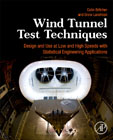
Wind Tunnel Test Techniques: Design and Use of Low- and High-Speed Wind Tunnels
Britcher, Colin
Landman, Drew
The wind tunnel itself is an instrument that involves the use of proper experimental techniques for best use. Wind tunnel testing without the use of proper experimental techniques can lead researchers and designers to draw inaccurate conclusions. Wind Tunnel Test Techniques: Design and Use of Low- and High-Speed Wind Tunnels provides an up-to-date, comprehensive treatment of the subject matter. Beginning with a brief history of wind tunnels along with the types and uses, the book goes on to cover subsonic, supersonic and hypersonic wind tunnel design and construction; calibration; boundary corrections; flow quality assessment; pressure surveys; and dynamic testing. The book also focuses on wind tunnel facilities which is useful for the designer and operator. Engineers and graduate students in aerospace, automotive and similar programs will find this book useful in their work with experimental aerodynamics, gas dynamics, facility design and performance. Deals with all the range of flow speed in wind tunnels from low speed to high speedProvides a discussion of similarity laws as well as material on statistical analysisIncludes coverage on facility-to-facility and facility-to-CFD correlationPresents advanced topics such as cryogenic wind tunnels, ground simulation in automotive testing, and propulsion testing INDICE: SECTION 1 Introduction 1. A brief history of the genesis of wind tunnels 2. Types and uses of wind tunnels 3. Dynamic similarity SECTION 2 Wind tunnel design and circuit aerodynamics 4. Subsonic wind tunnel design 5. Boundary interference assessment, alleviation, and correction 6. Model supports and support interference evaluation 7. Transonic wind tunnels 8. Supersonic wind tunnels 9. Hypersonic test facilities 10. Force and Moment Balances 11. Model design and construction 12. Special topics SECTION 3 Operational and Test Procedures 13. Statistical Engineering Practices 14. Wind tunnel calibration 15. Flow quality assessment 16. Force and moment measurements 17. Facility instrumentation 18. Planning of Test Campaigns SECTION 4 Wind tunnel test techniques 19. Pressure surveys 20. Dynamic testing 21. Facility-to-facility, facility-to-CFD, facility-to-flight correlation SECTION 5 Measurement Techniques 22. Flow visualization 23. Nonintrusive quantitative flowfield measurements SECTION 6 Postscript 24. The role of CFD in aerodynamic research 25. The future of ground testing SECTION 7 APPENDICES A. A primer on statistical engineering B. Strain-gage balance calibration example
- ISBN: 978-0-12-818099-0
- Editorial: Academic Press
- Encuadernacion: Cartoné
- Páginas: 1000
- Fecha Publicación: 01/07/2021
- Nº Volúmenes: 1
- Idioma: Inglés
